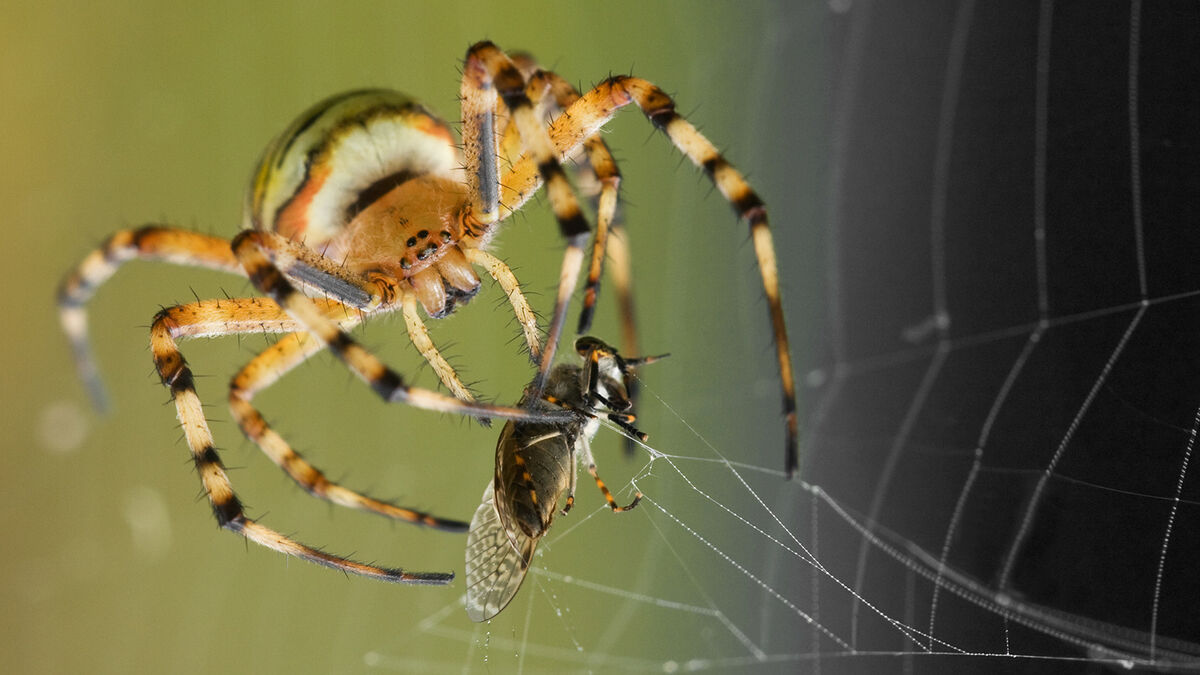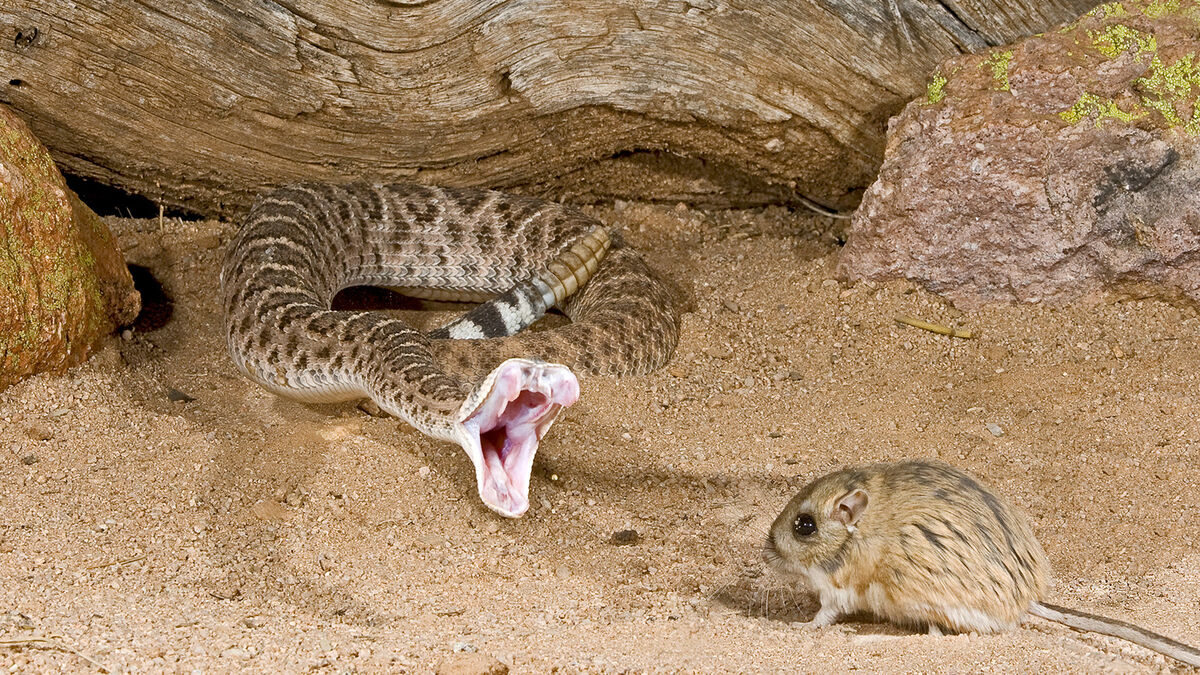
Predation involves one organism (the predator) catching and killing another organism (the prey) for sustenance. It may be easy to think of predators like bears, lions, or sharks, but can you think of other examples of predation in biology? Take a look at the ways predation keeps the circle of life going in various species.
Predation Examples in the Invertebrate World
Invertebrates, or animals without a backbone, include spiders, insects, and octopi. Unlike most other predators, invertebrates tend to eat their prey while it is still alive. Many invertebrates don’t hunt for food, preferring to set traps or lie in wait for their meal.
Some examples of invertebrate predation include:
- Spiders spinning webs to trap and kill insects
- Lacewings eating mites and small caterpillars
- Scorpions using their venomous stinger to kill insects and small mammals
- Octopi catching small fish and crustaceans
- Ladybugs feeding on aphids on apple trees and rose bushes
- Praying mantises eating a variety of insects, including crickets and other mantises
- Yellowjackets and wasps attacking house fly nests to eat their larva
- Fire ants swarming and carrying earthworms, caterpillars, and insect eggs to their anthills

Predation Examples in the Bird World
It seems odd to think of cute songbirds as vicious predators, but almost all birds hunt prey in some way. They are also often hunted by other predators in their food chains. In fact, eagles and condors are the only birds that don’t have natural predators.
You can see examples of bird predation in these situations:
- Sparrows catching insects to feed their young
- Woodpeckers drilling holes into tree bark to catch spiders, grubs, and insects
- Crows attacking other birds’ nests to eat their eggs
- Penguins catching fish under the ice
- Hawks circling and catching small animals such as lizards and snakes
- Seagulls swooping into the sea to catch small fish
- Owls stalking and killing mice and rats
- Eagles catching rabbits, large fish, and other animals in their talons
Predation Examples in the Fish World
You may have heard the expression “there’s always a bigger fish.” In the fish ecosystem, that saying is true – except maybe for the great white shark! Examples of fish predation include:
- Mollusks and shrimp eating zooplankton in the ocean
- Tuna consuming large amounts of fish from schools
- Piranhas in a feeding frenzy to eat a larger fish or animal
- Lionfish attacking large numbers of reef fish
- Sharks stalking and killing other fish, birds, or marine mammals
- Moray eels hiding and attacking smaller fish
- Manta rays sweeping small fish into their mouths as they swim
Predation Examples in the Reptile and Amphibian World
Most reptiles eat other animals for sustenance. Depending on the size of the reptile, their prey can be as small as a fly or as large as a gazelle. Their style is to strike when the moment is right rather than stalking and hunting their next meal.
Reptile and amphibian predation can include:
- Lizards catching and eating insects
- Frogs and toads extending long tongues to snatch flying insects
- Boa constrictors tightly squeezing their prey until it can’t breathe
- Crocodiles lurking under the surface of the water before grabbing an animal drinking at the water’s edge
- Turtles catching and eating small fish from the water
- Rattlesnakes using venom in their bite to kill small animals
- Ancient carnivorous dinosaurs attacking herbivorous dinosaurs

Predation Examples in the Mammal World
Mammals are often the apex predators of their food chains. They include big cats, canine packs, and marine mammals. Even your house cat is considered a predator!
Here are some ways you’d see predation by mammals:
- A pride of lions attacking a larger animal, such as an elephant or wildebeest
- Dolphins chasing and eating fish
- Orca whales hunting seals, sharks, and penguins
- House cats killing mice, birds, and other small animals
- A pack of coyotes chasing and killing rabbits
- Tigers stalking and killing deer in the forest
- Bears fishing salmon out of the river
Predation Examples in the Plant World
Did you know that plants can be predators, too? Although carnivorous plants can’t exactly move around to hunt their prey, they can wait for the perfect opportunity to consume insects or small animals. Some predatory plant behavior includes:
- Venus fly traps snapping shut on insects
- California pitcher plants using digestive enzymes to consume insects that fall inside its pitcher
- Sundews attracting and then absorbing insects with sticky mucilage
- Yellow pitcher plants secreting an intoxicating nectar to bring prey to the bottom of its pitcher
- Bladderworts using negative pressure to suck prey into their bladders
- Corkscrew plants trapping microfauna and protozoa in their underground “lobster-pot style” mazes

Predation Examples in the Microscopic World
You don’t have to be big to be the top of your food chain. Microscopic organisms can be predators as well. Here are some examples of microscopic predation:
Common Traits of Predators
Some consider any type of eating behavior that involves using another organism as predation. However, there are a few traits that one can typically attribute to predators. Keep reading to learn what these traits can be.
- Predators are higher on the food chain than their prey.
- They are usually larger than their prey. If not, they tend to attack their prey as a pack or group (e.g., lions, wolves, ants).
- Most predators seek a range of prey and do not feed on only one type of animal.
- Predators have evolved for the purpose of catching prey (e.g., camouflage, sharp teeth, claws).
- Predatory animals and plants alike possess heightened senses for finding prey.
While predators are especially good at catching prey, prey organisms have also developed impressive defense techniques. If a predator fails to catch lunch, they can try again, but too many failures and they will starve. If prey fails to escape a predator, their life is over and they can no longer reproduce. The stakes are high in each example of predation.
How the Food Chain Works
Predation is nature’s foolproof population control method. Without it, the world would be overrun with herds of herbivores or swarms of insects. Learn more about how various food chains work to keep ecosystems balanced with these examples of food chains.